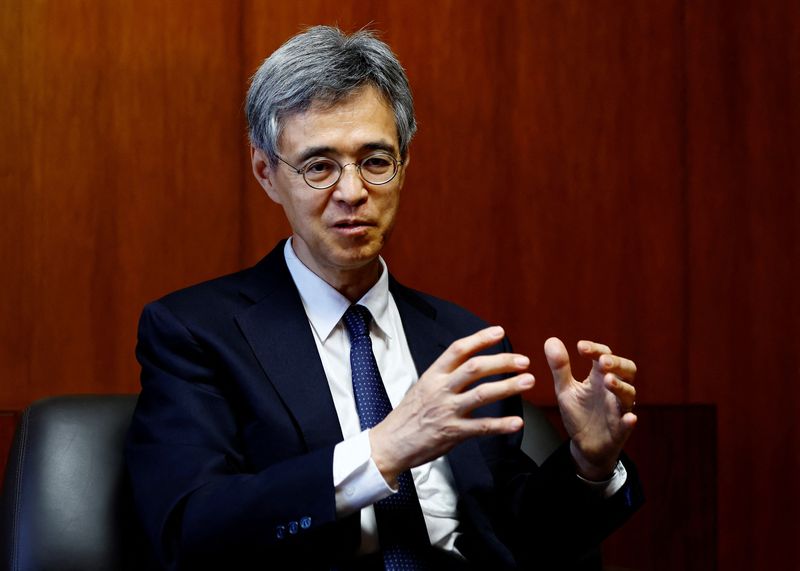By Leika Kihara and Takahiko Wada
TOKYO (Reuters) – Bank of Japan (BOJ) Deputy Governor Ryozo Himino said recent price rises were stronger than previously projected and inflation expectations were moving up, a sign the economy is getting closer to achieving the bank’s 2% inflation target.
While stressing the need to keep ultra-loose monetary policy for now, Himino said the economy was beginning to see a mix of cost-push inflation and price gains driven by domestic demand.
“The pass-through of rising imported goods prices is broadening with a lag. But other factors may also be playing a part such as labour shortages, strong domestic demand, and changes in corporate price-setting behaviour,” Himino told Reuters in an interview conducted on Wednesday.
“We believe the pass-through from rising imported goods prices is still a dominant factor, but need to scrutinise the contribution of newly emerging factors that are pushing up prices,” he said.
His remarks were the clearest sign to date that BOJ policymakers see wage and demand factors playing an increasing role in driving up Japan’s inflation.
They also highlight the chance of a gradual shift in the BOJ’s key arguments for maintaining ultra-loose policy – that price spikes were mostly driven by surging raw materials costs and would ease later this year.
“Recent rises in consumer inflation in Japan are much more modest than in the United States or Europe, but fairly stronger than previously expected,” Himino said.
Various surveys and market indicators also show Japan’s inflation expectations were “moving up somewhat from a very low level,” he added.
Himino declined to comment on how soon the BOJ could phase out stimulus, but said he was closely watching consumer inflation data and briefings from regional BOJ branch managers gathering for a quarterly meeting on July 10 to see if price rises are broadening.
“We’ll of course respond flexibly with an eye on the economy, prices and financial developments,” said Himino, a former top bank regulator who assumed the current post in March. “Given the state of the economy, however, the best approach now is to maintain ultra-easy monetary policy.”
MARKET SIGNALS IMPORTANT
Himino was one of two new deputy governors appointed this year as part of the central bank’s new leadership, which was initially seen by markets as moving steadily toward dismantling former Governor Haruhiko Kuroda’s radical stimulus programme, and raising interest rates.
To date, however, new Governor Kazuo Ueda has mostly reiterated Kuroda’s arguments that continued monetary stimulus is needed to revive demand.
Japan’s core consumer prices rose 3.2% in May from a year earlier and have held above the BOJ’s target for 14 straight months, casting doubt on its view the recent cost-driven inflation will moderate from around October.
Some analysts warn the BOJ, like its U.S. and European peers, may be underestimating the risks of excessive inflation in the future.
“We’re not seeing any sign of risk that Japan would experience the kind of high inflation seen in the United States and Europe,” Himino said. “But the economy is a living thing. We need to humbly look at how various factors come into play.”
A weakening yen, caused by the widening gap between Japanese and U.S. interest rates, has also fanned imported inflation pressures. The currency hit a fresh seven-month low against the dollar on Wednesday.
Markets are anxiously looking for clues on when the BOJ might tweak yield curve control (YCC) – a policy that sets a 0% target for the 10-year bond yield with an allowance band of 50 basis point around the target.
A policy tweak by the BOJ could have huge global market repercussions.
An expert on financial regulation and banking affairs, Himino said Japan’s banking system was sound and had sufficient buffers to weather any rate rises.
Himino declined to comment on whether the BOJ could widen the allowance band around its yield target to address the side effects of YCC, such as distortions in market pricing caused by its huge bond purchases.
But he said the BOJ must be vigilant to market signals and the effects asset price moves could have on the economy.
“We need to carefully interpret the messages coming out from markets,” Himino said. “As for how we would respond with policy, it would be a comprehensive decision looking at the baseline scenario and risks surrounding the economy, prices and financial developments.”
(Reporting by Leika Kihara and Takahiko Wada; Editing by Sam Holmes and Catherine Evans)
